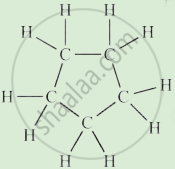Advertisements
Advertisements
Question
Elements forming ionic compounds attain noble gas electronic configuration by either gaining or losing electrons from their valence shells. Explain giving reason why carbon cannot attain such a configuration in this manner to form its compounds. Name the type of bonds formed in ionic compounds and in the compounds formed by carbon. Also explain the reason why carbon compounds are generally poor conductors of electricity.
Solution
The atomic number of carbon is 6. This means that it has 4 electrons in its outermost shell and it needs 4 more electrons to attain noble gas electronic configuration. It cannot form C4+ cation, as the removal of 4 valence electrons requires a huge amount of energy. Moreover, the cation formed will have 6 protons and 2 electrons which makes carbon highly unstable. Carbon cannot form C4− anion, as its nucleus with 6 protons cannot hold 10 electrons. Thus, carbon achieves noble gas electronic configuration by sharing its 4 electrons with other elements; it forms covalent compounds.
In ionic compounds, ionic bonds are formed, while in carbon compounds, covalent bonds are formed.
As carbon compounds are covalent in nature and lack free electrons so they are bad conductors of electricity.
APPEARS IN
RELATED QUESTIONS
Write structural formula of Methane.
List three characteristic properties of covalent compounds.
An element L consists of molecules.
What type of bonding is present in the particles that make up L?
Friedrich Wohler converted an inorganic compound into an organic compound in the laboratory.
Write the name and formula of organic compound formed.
will CCl4 conduct electricity or not?
give reason for your choice.
Explain why, diamond is hard while graphite is soft (though both are made of carbon atoms).
Explain why, graphite can be used as a lubricant but diamond cannot.
The organic compound prepared by Wohler from an inorganic compound called ammonium cyanate was:
(a) glucose
(b) urea
(c) uric acid
(d) vinegar
The number of isomers formed by the hydrocarbon with molecular formula C5H12 is:
(a) 2
(b) 5
(c) 3
(d) 4
Methane molecule is non-polar molecule. Explain.
State the type of bonding in the following molecule.
Methane
Explain the Structural isomerism term with example.
Give examples for the following:
Two solid covalent compounds.
(a) Compound X consists of molecules.
Choose the letter corresponding to the correct answer from the choices (a), (b), (c) and (d) given below
In the liquid state, X will
What is the term defined below?
A bond formed by a shared pair of electrons, each bonding atom contributing one electron to the pair.
State the type of bond formed when the combining atom has zero E.N. difference.
Fill in the blank and rewrite the completed statement:
Covalent compounds are generally soluble in _________ solvents.
Complete the following activity.
Write the names of the hydrocarbons for the following structural formula.
(isobutylene, cyclohexane, propene, cyclohexene, cyclopentane, benzene, propyne, isobutane, propane)
 |
When ethyl alcohol and acetic acid are mixed, the resulting ester has a chemical formula ______.
The correct structural formula of butanoic acid is
